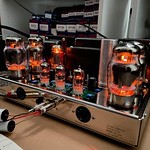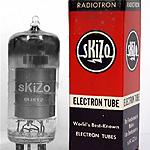Anyone use ceramic sockets instead of the one provided in the kit ST120 or ST70 or are the ones in the kit ok. Thoughts on best material for sockets. I know military used ceramics alot
5 posters
Tube sockets

Bob Latino- Admin
- Posts : 3276
Join date : 2008-11-26
Location : Massachusetts
- Post n°2
 Re: Tube sockets
Re: Tube sockets
Surfwax wrote:Anyone use ceramic sockets instead of the one provided in the kit ST120 or ST70 or are the ones in the kit ok. Thoughts on best material for sockets. I know military used ceramics alot
I do not use and do not recommend ceramic OCTAL tube sockets. Reason > Ceramic sockets have no "give". You are much more likely to break a center guide pin using a ceramic socket when removing a tube. You wiggle the tube back and forth during removal just a little too much and the plastic center guide pin can break. I know because I have done it ! That said, I do like ceramic 9 pin noval sockets for the driver board.
The octal sockets on all the VTA amps are Celanex sockets. Celanex is a fiberglass reinforced polycarbonate material which is much harder and much more heat resistant than the old "plastic" sockets found on the original Dynaco amps.
Bob

corndog71- Posts : 840
Join date : 2013-03-19
Location : It can get windy here
- Post n°3
 Re: Tube sockets
Re: Tube sockets
I prefer Belton sockets as they offer superior grip. The downside is that they don't want to let go. Not recommended for tube rollers. I agree with Bob on ceramic octals. Not recommended.

sKiZo- Posts : 1530
Join date : 2013-04-01
Location : Michigan USA
- Post n°4
 Re: Tube sockets
Re: Tube sockets
I've been known to roll a few and have no issues with the sockets provided with the kit. Then again, I retension them with every roll - good habit to get into, and it doesn't take all that much time. I've got a neat lil ceramic screwdriver that's perfect for the job - just insert it between the socket wall and finger, and give it a slight twist to push them a bit towards center on each pin.
These sockets DO have a lot of slop in them compared to some. Easy solution to that is to carefully give each pin connector a slight twist underneath using flat nose pliers. This easy step removes a lot of that slop.
These sockets DO have a lot of slop in them compared to some. Easy solution to that is to carefully give each pin connector a slight twist underneath using flat nose pliers. This easy step removes a lot of that slop.

Roy Mottram- Admin
- Posts : 1838
Join date : 2008-11-30
- Post n°5
 Re: Tube sockets
Re: Tube sockets
just a bunch of FYI learned over the years . .
for many dozens of years, ceramics were recommended because of heat issues. We've all see old original Dyna PAS3s and ST70s from the 60s with burnt PCBs around the sockets.
I tried to use ceramics a dozen or more years ago. Immediately found out they caused or increased microphonics in tubes. So the recommended sockets because Micalex.
A few years ago I found some ceramic sockets of different design than previously available. I now use these in my preamps, but not in power amps.
Ceramic sockets not only break easily, but as Bob said, they can easily break off the octal guide pin. I've only broken one in an SP14 preamp. Not an issue with 9 pin tubes.
But in general, Belkin micalex or celanex sockets are the best.
for many dozens of years, ceramics were recommended because of heat issues. We've all see old original Dyna PAS3s and ST70s from the 60s with burnt PCBs around the sockets.
I tried to use ceramics a dozen or more years ago. Immediately found out they caused or increased microphonics in tubes. So the recommended sockets because Micalex.
A few years ago I found some ceramic sockets of different design than previously available. I now use these in my preamps, but not in power amps.
Ceramic sockets not only break easily, but as Bob said, they can easily break off the octal guide pin. I've only broken one in an SP14 preamp. Not an issue with 9 pin tubes.
But in general, Belkin micalex or celanex sockets are the best.

